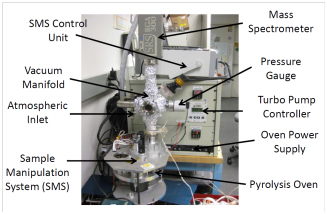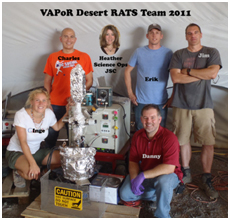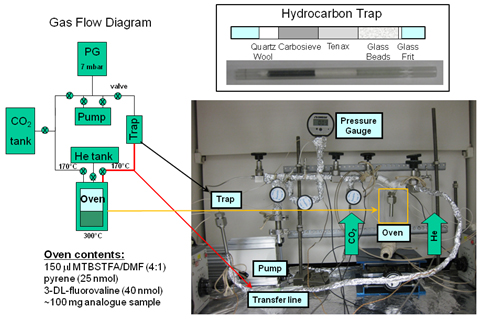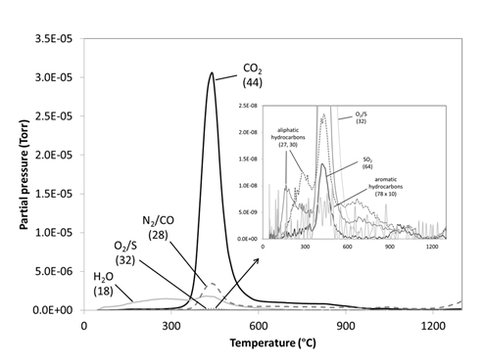2011 Annual Science Report
 NASA Goddard Space Flight Center
Reporting | SEP 2010 – AUG 2011
NASA Goddard Space Flight Center
Reporting | SEP 2010 – AUG 2011
Research Activities in Planetary Environments Lab
Project Summary
A new instrument called VAPoR (Volatile Analysis by Pyrolysis of Regolith) was developed to demonstrate an end-to-end pyrolysis time of flight mass spectrometer system with sufficient mass resolution, mass range, sensitivity, precision, and dynamic range to be applied to astrobiology missions. The mass spectrometer derived from this development can be used as an in situ detector of water, noble gases, oxygen, and other potential biomarkers such as organic molecules that are signatures of extinct or extant life and isotopic composition of elements such as C, H, and S that are fractionated by biological processes. A small lightweight mass spectrometer such as VAPoR will conserve precious mass, power, and volume resources in future missions to polar regions of the Moon, asteroids, comets, Mars, Europa, Enceladus, or Titan. The VAPoR instrument was tested most recently during the 2011vDesert Research and Technology Studies (DRATS) field campaign where detailed in situ bulk chemical characterization of volatiles released from regolith samples was carried out.
Project Progress
VAPoR Project Overview:
Daniel Glavin is the principal investigator of an ASTID project entitled “Volatile Analysis by Pyrolysis of Regolith” to develop and demonstrate an end-to-end pyrolysis time of flight mass spectrometer instrument prototype with sufficient mass resolution, mass range, sensitivity, precision, and dynamic range to be applied to astrobiology missions. The mass spectrometer derived from this development is intended to be an in situ detector of water, noble gases, oxygen, and other potential biomarkers such as organic molecules that are signatures of extinct or extant life and isotopic composition of elements such as C, H, and S that are fractionated by biological processes. A small lightweight mass spectrometer will conserve precious mass, power, and volume resources in future missions to polar regions of the Moon, asteroids, comets, Mars, Europa, Enceladus, or Titan. The VAPoR instrument will enable a detailed in situ bulk chemical characterization and isotopic analyses of volatiles released from regolith samples and volatiles present in the atmosphere or exosphere of airless bodies to establish the origin of the volatiles and to explore for resources that could be used by a future human mission.
The ASTID is currently in the final year of a 4 year development effort where the end product will be an end-to-end TRL 5 prototype that could be proposed to a future lunar lander, comet/asteroid, Titan or Mars astrobiology mission. During this performance period, Glavin also obtained funding through the Moon and Mars Mission Analog Activities (MMAMA) program to field test a portable version of the VAPoR instrument (Fig. 1) as part of integrated field campaigns including International Lunar Science Operations/In Situ Resource Utilization (ILSO/ISRU) in Hawaii and Desert Research and Technology Studies (DRATS) in Arizona. The key ASTID/MMAMA accomplishments during this performance period include: (1) integration of the Honeybee Robotics sample manipulation system to the field unit; (2) fabrication of a high temperature oven capable of heating solid samples up to 1400°C; (3) completed fabrication and integration of a new extended ion lens assembly and housing with low power carbon nanotube (CNT) e-gun for the reflectron time of flight mass spectrometer (TOF-MS); and (4) successful field demonstration of VAPoR evolved gas analyses during the 2011 DRATS asteroid simulation in Arizona. An example of a VAPoR evolved gas analysis of a vesicular basalt carried out during DRATS is shown in Fig. 2.

Figure 1 Left. Main components of the VAPoR instrument (left) and the field team with the instrument during DRATS field operations.

Figure 1 Right. Main components of the VAPoR instrument (left) and the field team with the instrument during DRATS field operations.
Figure 2. VAPoR evolved gas analysis of DRATS sample 0212, a vesicular basalt collected at Black Point Lava Flow in Arizona, showing selected inorganic and organic volatiles released under vacuum after heating from ambient up to 1300ºC.
The VAPoR ASTID and MMAMA work has led to the following relevant peer-reviewed publications and conference proceedings:
Glavin, D.P., Getty, S., Southard, A., ten Kate, I. L., Malespin, C., Noreiga, M., Franz, H. B., Dobson, N., Mumm, E., Feng, S., Kotecki, C., Bleacher, J., Rice, J., Swindle, T., Mahaffy, P. R. In Situ Volatile Analysis by Pyrolysis of Regolith (VAPoR) for Planetary Resource Exploration, IEEE Aerospace Conference, March 3-10, Big Sky, Montana, manuscript submitted, in review.
ten Kate I. L., Armstrong R., Boucher D., Caillibot E., Captain J. E., Deleuterio G., Farmer J. D., Glavin D. P., Hamilton J. C., Nuñez J. I., Quinn J. W., Sanders G. B., Sellar R. G., Sigurdson L., Taylor R., Zacny K. Instrument field-testing in a Mauna Kea crater – implications for future mission preparation. Journal of Aerospace Engineering, in review.
ten Kate, I.L., Cardiff, E.H., Swindle, T.D., Johnson, C.S., Feng, S.H., Holmes, V., Malespin, C.A., Stern, J.G., Dworkin, J.P., and Glavin, D.P. (2010) Volatile Analysis by Pyrolysis of Regolith: The VAPoR Instrument Development. Global Lunar Conference Proceedings, GLUC-2010.1.7.B.8, Beijing, China.
Getty, S. A., ten Kate, I. L., Feng, S. H., Brinckerhoff, W. B., Cardiff, E. H., Holmes, V. E., King, T. T., Li, M. J., Mumm, E., Mahaffy, P. R., and Glavin, D. P. (2010) Development of the VAPoR Instrument: a Pyrolysis-Time-of-Flight Mass Spectrometer. International Journal of Mass Spectrometry 295, 124-132.
Ten Kate, I.L., Cardiff, E.H., Dworkin, J.P., Feng, S.H., Holmes, V.E., Malespin, C.A., Stern, J., Swindle, T.D., and Glavin, D.P. (2010) Validation of the VAPoR instrument concept for in situ evolved gas analysis and resource exploration on the Moon. Planet. Space Sci. 58, 1007-1017.
Overview of Analog Studies Supporting the SAM Wet Chemistry Experiment:
The search for complex organic molecules on Mars, including important biomolecules such as amino acids, carboxylic acids, and nucleobases will require a chemical extraction and derivatization step to transform these molecules into species that are sufficiently volatile to be detected by gas chromatography mass spectrometry (GCMS). Indeed, these key organic compounds important to biology would have been missed by the GCMS instruments onboard the landers of the Viking mission in 1976 since these compounds require chemical derivatization to be stable in a GC column. Glavin helped lead the development of a one-pot extraction and chemical derivatization protocol using N-methyl-N-(tert-butyldimethylsilyl)trifluoroacetamide (MTBSTFA) and dimethylformamide (DMF) for the Sample Analysis at Mars (SAM) experiment on the Mars Science Laboratory (MSL). Although the wet chemistry experiment was not tested on the SAM flight instrument, a test-bed was developed (Fig. 3) in order to optimize the extraction of organic compounds from several Mars analog samples under realistic SAM experimental conditions. We found that the influence of the mineral matrix and chemical composition on derivatization, especially the presence of hydrated minerals and oxides in martian samples, will be a major constraint in the ability for SAM to detect amino and carboxylic acids using MTBSTFA. The most promising result was the extraction and detection of amino acids in a carbonate stromatolite sample from Svalbard. The results from this Mars analog study is summarized in Stalport et al. (submitted, in revision) provide an important framework for andthe sample selection and organic compound detection strategy for the SAM derivatization experiment on the 2011 Mars Science Laboratory (MSL) mission

Figure 3. Flow diagram and photo of the experimental setup used to extract organic compounds from Mars analogue materials under SAM like experimental conditions
This research has led to the following relevant peer-reviewed publications and conference proceedings:
Stalport, F., Glavin, D.P., Eigenbrode, J., Bish, D., Blake, D., Coll, P., Szopa, C., Buch, A., McAdam, A., Dworkin, J.P., and Mahaffy, P.R. (2011) Analysis of organic molecules extracted from Mars analogues using N-methyl-N-(tert-butyldimethylsilyl)trifluoroacetamide derivatization coupled with gas chromatography mass spectrometry in preparation for the Sample Analysis at Mars derivatization experiment on the Mars Science Laboratory mission. Planet. Space Sci. under revision.
Glavin, D.P., Conrad, P., Dworkin, J.P., Eigenbrode, J., and Mahaffy, P.R. (2011) The importance of sample return in establishing chemical evidence for life on Mars or other solar system bodies. Solar System Sample Return Workshop: Life in the Solar System and the Importance of Water, Session 112, The Woodlands, TX, March 5, 2011.
Publications
-
Getty, S. A., Ten Kate, I. L., Feng, S. H., Brinckerhoff, W. B., Cardiff, E. H., Holmes, V. E., … Glavin, D. P. (2010). Development of an evolved gas-time-of-flight mass spectrometer for the Volatile Analysis by Pyrolysis of Regolith (VAPoR) instrument. International Journal of Mass Spectrometry, 295(3), 124–132. doi:10.1016/j.ijms.2010.06.020
-
Ten Kate, I. L., Cardiff, E. H., Dworkin, J. P., Feng, S. H., Holmes, V., Malespin, C., … Glavin, D. P. (2010). VAPoR – Volatile Analysis by Pyrolysis of Regolith – an instrument for in situ detection of water, noble gases, and organics on the Moon. Planetary and Space Science, 58(7-8), 1007–1017. doi:10.1016/j.pss.2010.03.006
-
PROJECT INVESTIGATORS:
-
RELATED OBJECTIVES:
Objective 2.1
Mars exploration.
Objective 2.2
Outer Solar System exploration
Objective 7.1
Biosignatures to be sought in Solar System materials

